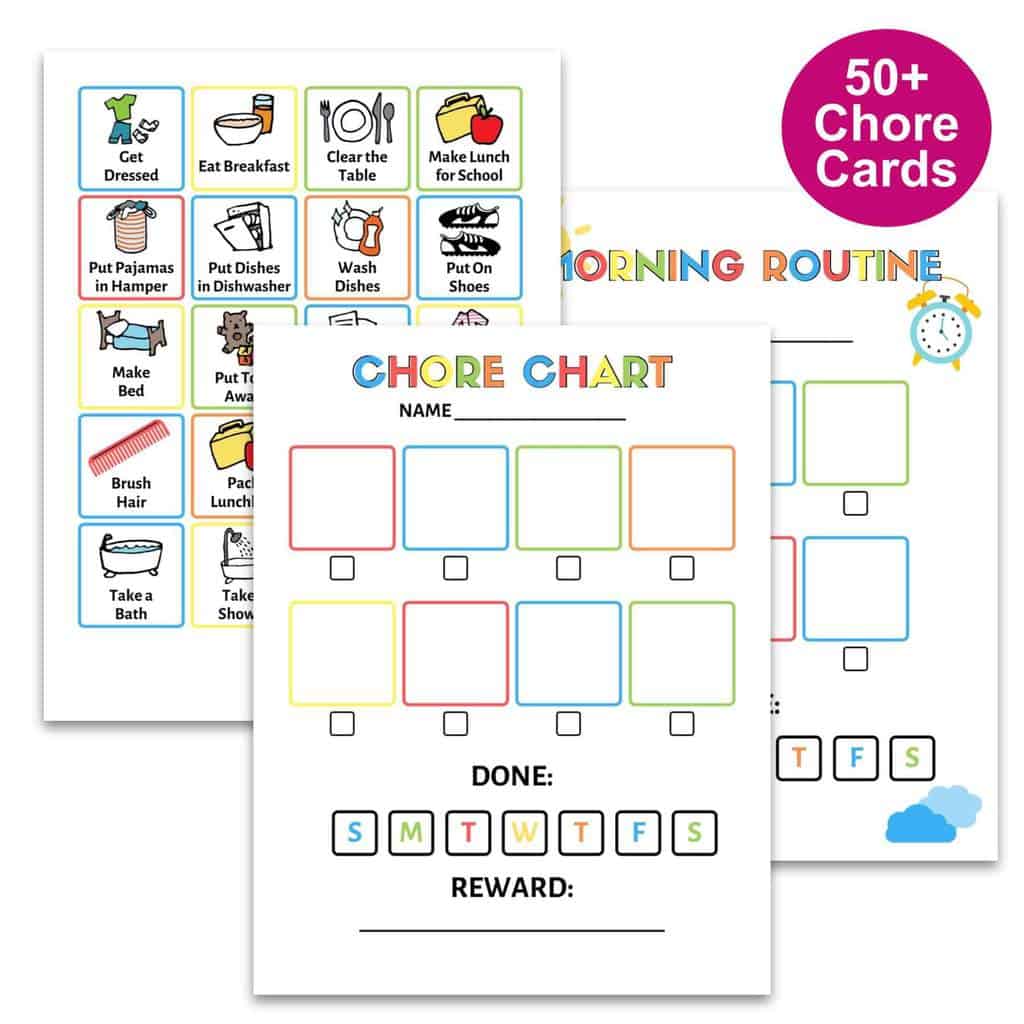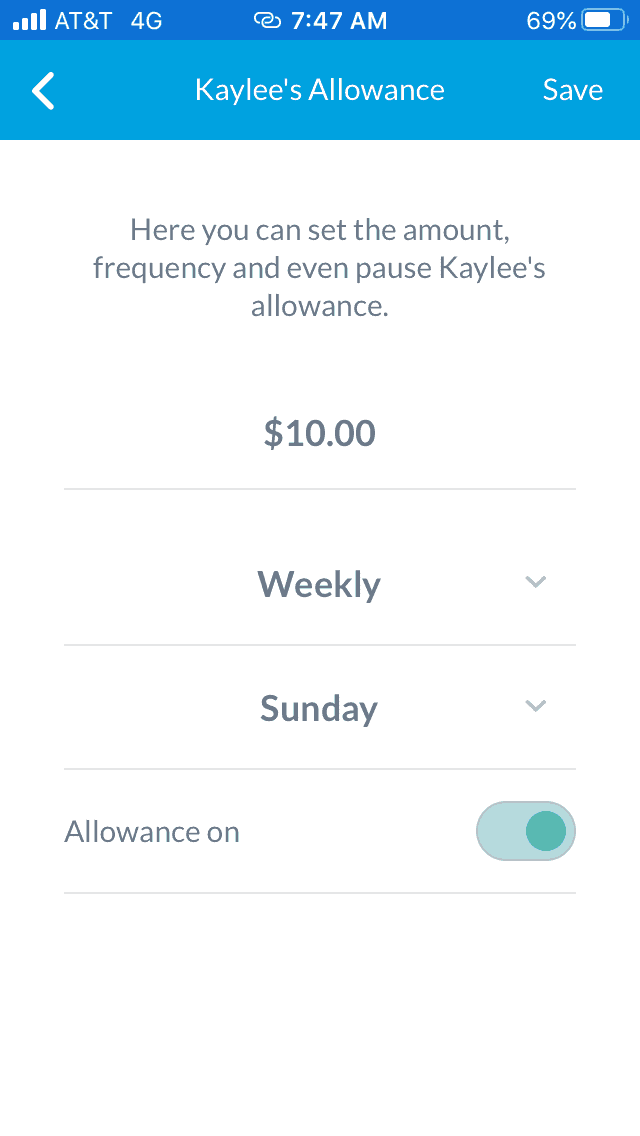If your family chore chart is just a waste of space on your fridge, then read this! Here are 8 common reasons why your chart isn’t working for you, and how to make a chore chart that you’ll actually use.
Most families struggle with chores. Kids don’t like doing them any more than we do and unlike us, kids don’t seem to actually see when something needs to be done. A kid is highly likely to walk past a sink full of dishes or an overflowing trash can without a thought about them… Or magically cross a sea of Legos on the floor without even a glance downward.
One way families help fix this issue is by assigning chores and using a chore chart.
But the problem is, most moms start a new chore chart with excitement only to find that they only keep up with it for the first week or so (that’s the reason why I developed this Kids’ Chore Chart with Chore Cards!).
Here are some reasons why your chore chart may not be working for you and your family:

Your chore chart is not highly visible
The problem:
Out of sight, out of mind is a real issue when it comes to family chore charts. If your child doesn’t see their chore chart right in front of them in an area they are passing multiple times a day, they are likely to forget all about it… and so are you.
The fix:
Place your chore chart somewhere that everyone will see it frequently. This will help your child see that they need to do their chores and help you see when they didn’t mark their chores as done yet. A great place for this is right on the refrigerator door or hanging on the wall in your family command center.
Your chore chart is not easy enough to understand
The problem:
Often when parents make a chore chart they simply scribble the chores down on the line and leave it. This can lead to issues for children whether they can read well or not… and if your handwriting looks like a bunch of chicken scratch like mine does, then even an advanced reader could have problems with your family chore chart.
For younger kids, a written list is not a good choice because they not only may struggle to read it, but they could also have difficulty comprehending exactly what is expected of them.
The fix:
To fix this issue, you can use a visual chore chart with picture chore cards like we do. Visual chore charts are proven to be more effective simply because they are easier to remember and understand.

You can also use a combination of photos and words like the chore cards above in order to help with reading and comprehension skills.
Here are some ideas for making your own picture chore charts for kids:
- Make your own chore chart by printing your photos of family members doing various chores around the house. Then laminate them and turn them into a chart.
- Have your kids draw pictures of different chores on index cards. Laminate the cards and velcro them to a poster board. Since your kids helped to make the chore chart, they may be more excited to use it.
- Purchase a printable chore chart with chore cards and use the download to create your own family chore chart. You can check out the chore chart we use here!

Consistency is an issue
The problem:
Most people struggle with consistency. Kids are no different and will often forget about chores and tasks simply because they aren’t part of their daily routine.
And while we often make chore charts to help fix issues with consistency, in the end, just having a chart won’t solve the problem… you actually have to implement it consistently.
The fix:
Your job as the Momma is to work on building constancy and routines into your child’s life. Set designated times for chores and work them into your child’s daily schedule to help build consistency and give your family chore chart a fighting chance at actually getting used.
There are no “easy wins” on your kids’ chore charts
The problem:
If every single job on your child’s chore chart is difficult and time-consuming, like folding the laundry or washing the dishes, then they can get discouraged.
The fix:
Include some “easy win” jobs that take only a minute or two to complete, so that your kids can check something off their lists (like accomplishing a micro-goal), and be more motivated to keep going.
These smaller chores could include things like feeding the dog, taking out the trash, or putting dirty clothes in the hamper.
Your chore chart is not flexible enough
The problem:
One of the most common problems with keeping up with a chore chart is the lack of flexibility that it provides.
Most chore charts only consist of lines and a row of boxes for you to place a check mark in once the chore is completed. Typically, each of those boxes is labeled with a different day of the week to indicate that each chore was completed everyday.
However, what happens when certain chores only need to be done once or twice a week rather than everyday? Then, your chore chart has big blank boxes and it looks like jobs were not finished properly.
The fix:
I created my kids’ chore chart system with this exact problem in mind, and I set out to make a chart that could easily be changed from day-to-day while at the same time keeping a record of whether or not chores were completed each day of the week.
Each day, I change the chore cards on my girls’ chore charts (they’re laminated and stick on with velcro!), and they have until the end of the day to check everything off the chart. Each night I check to make sure that all of the chores were done, and if they were, then I mark an “X” through that day on the bottom of the chart. Then, I can change the chores that need to be done for the next day:

There’s no incentive to complete the chore chart
The problem:
Chore charts are boring. And while as an adult, we may find marking things off our to-do lists satisfying, kids typically don’t get that same satisfaction with a little check mark… No… Kids want an actual, tangible reward like ice cream or money.
And often times, if there is no reward attached to completing the chore chart, then there’s no motivation to get the chores done.
The fix:
To give your family chore chart a chance, combine the chart with a reward to encourage your child to do their chores. Offer a reward for consistency in continuously doing what needs to be done rather than ignoring the chore chart.
For most kids, money is a great incentive for completing chores. Or, if your kids are younger, you could use reward coupons good for things like:
- One new book
- One new toy
- McDonald’s for dinner
- A trip to the local ice cream shop
- Staying up 30 minutes late
- An extra 30 minutes of screen time
Our daughters get a weekly allowance, assuming that they are doing well in school and that they’ve been helping around the house. However, I quickly discovered that a cash allowance didn’t work for our family, so I use allowance trackers to give my kids allowance without cash.
Here is a screen shot of my absolute favorite allowance tracker app:

You can read more about how to give your kids allowance without cash (and without having to always run to the ATM) here!
The chores are imbalanced
The problem:
If you have multiple children it can be hard to find a balance between them all when assigning chores, especially if you often hear “Mom, that’s not fair!”. Each child has their own abilities and maturity level, and while older kids can handle more responsibility, they can often feel discouraged if their younger siblings aren’t doing as much.
The fix:
A great way to make chores more fair is to involve your kids in the assignment of responsibilities. Separate the chores based on age range, and allow your kids to pick from the chores that fit their abilities. You could also rotate unpopular chores so that the same child isn’t always stuck doing the “grunt work”.

Don’t shy away from giving younger kids chores as well. Even your preschooler can help pick up toys, feed the family pet, and help you fold washcloths. By assigning chores to even the young kids, you are helping make chores feel more fair to older kids.
Charts are not for everyone
The problem:
We’re all wired differently, and sometimes what works for one person doesn’t work for someone else. Sometimes it’s not your chore chart that is the problem. Chore charts are great, but they are not a one size fits all situation. Some families need a different method for getting chores organized and completed.
The fix:
If you find that your family absolutely CAN NOT keep up with a chore chart, then try another type of chore system. A fun option is to put all of the chores that your child can do onto a popsicle stick and create a chore jar. This is a great activity for a once-a-week cleaning day or spring cleaning.
Other Cleaning Checklists
If your kids are too old for a chore chart, or even if you want a more grownup version, then a cute cleaning checklist may be for you! You can use a detailed checklist of cleaning jobs to be completed daily, weekly, or semi-annually for deep cleaning.

Visit this post for a cute printable Kitchen Cleaning Checklist! And then grab the matching free printable Bedroom Cleaning Checklist here!
I hope you’ve picked up some good tips for how to make a chore chart that will actually work for your family! What would you say is the number one reason why your chore chart is just a waste of space? Leave me a comment down below!
And happy nesting!


Leave A Reply!